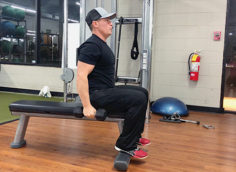I was seven years old the first time I saw a picture of a bodybuilder. One of my classmates had a copy of the 1978 Guinness Book of World Records. As we rode the noisy bus home from our school in rural northern Alberta, he handed it to me.
"Look at that!"
The book was open to a picture of a guy in what looked to be his underwear, with this caption: "World's most perfectly developed man." I stared at the picture in awe.
Growing up on a farm, I'd seen a lot of physically powerful men with broad backs, Popeye forearms, and barrel chests, which of course this bodybuilder had in exaggerated quantities. What got my attention was his incongruously small, concave waist, with snake-like muscles running across it. I'd never seen a midsection like that. Where I grew up, the strongest men had thick waists that grew rounder as they got older, a product of the massive home-cooked meals that fueled the grueling physical labor they performed.
Then and there, I decided I would somehow, someday, look like that man with the memorable physique and unpronounceable name.
That was 31 years ago, but I remember it like it was yesterday. The biggest difference between then and now is the fact I'm joined by millions of people chasing that chiseled waistline. You couldn't possibly count all the gyms, all the infomercial products, all the websites offering you the roadmap to ripped abs.
Beyond the gadgets are the endless articles on functional core training. Don't get me wrong; I'm in favor of functional training. But as a professional bodybuilder, I'm interested in form first, and function second. Go ahead, tell me I'm me vain. I don't mind because it's true. The functional benefits that come with my style of mid-body training are a bonus. I don't care if saying as much mobilizes an army of personal trainers to jump off their balance boards and Bosu balls and come after me with their Bodyblades.
I'll say it loud and say it proud: I train my abs for show.
Where Form Meets Function
Whether you're training your abs for function or form, you should know how the muscles of your midsection work. Without that knowledge, it's difficult to train them properly and efficiently. This subject is typically covered by people with a lot more letters after their names, so I'll keep it simple.
Your abdominal muscles perform three basic functions:
- The rectus abdominis, the six-pack muscle, works with the obliques to perform spinal flexion, bringing your pelvis and chest closer together.
- The external and internal obliques also act in rotational and twisting motions, but, just as important, they act to prevent twisting when your torso needs to hold a stable position.
- Finally, the internal obliques and transverse abdominis, the innermost abdominal layers, help compress the abdomen and provide support to the midsection against the pull of gravity. In simple terms, these endurance-oriented muscles helps you stand up straight and keep your gut from sticking out.
So when I put together a strategy to achieve maximum abdominal development and clarity, it has to ...
- Work the ab muscles with all three actions – spinal flexion, rotation and anti-rotation, and abdominal compression.
- Train the muscles to maintain an isometric contraction in the ab musculature.
- Help me achieve a very low level of body fat.
I doubt if #1 and #3 are a surprise to anyone reading this. But #2 is often overlooked. Without being able to maintain an isometric contraction for a long period of time, you end up being the guy who has perfect abs when he poses, but a gut that sticks out like the Octomom's when he's relaxed. Training your abs for isometric endurance keeps your abs "popping" even when you seem to be relaxed. It's obviously important to me, as a competitive bodybuilder, to be able to hold my gut in between poses. But it also comes in handy for you when you're hanging out on the beach and trying to catch the eye of someone who's a bit out of your league.
It's also important for me – and probably for you – to do this as efficiently as possible. I'm a very busy guy. Besides working 10 to 12 hours a day on my business, I usually do one or two shows a years that require me to train eight to 10 hours per week.
On top of those time and energy constraints, I don't particularly enjoy training abs, and I hate doing cardio. So I do my ab training in a circuit fashion, which not only saves time but also creates an oxygen debt, which reduces the amount of cardio I have to do to get into contest condition.
Here's an example of one of my circuits.
A. One-Leg Hip Extension with Cross-knee Drive from Plank Position: 10 to 15 reps per side
This is a great three-for-one exercise. It works the anti-rotation function of the obliques, forces all the abdominal muscles to hold a difficult isometric contraction, and produces as much oxygen debt as you could hope for. It's the ab-training equivalent of a subprime mortgage.
You can do it with your feet on a bench ...
Or, if that's not challenging enough, you can put your feet on a Swiss ball:
B. Seated Bicycle Abs: 15 to 30 seconds in each direction
This one works the rotation/anti-rotation functions of the obliques, with a mild isometric contraction of the rectus abdominis. You can hold your hands in two different positions, as I show in the video – at your sides, or overhead.
C. 45-degree V-Up with a Reach: 8 to 15 reps
This is a pretty straightforward flexion exercise for the rectus and obliques.
D. Ab Rollout: 8 to 15 reps
Rollouts hit the rectus hard by challenging your ab muscles as they extend. I show this one two different ways – using a Swiss ball or ab wheel.
E. Vacuum hold: 30 to 60+ seconds
Vacuums are the ultimate isometric, anti-gut-bulge exercise, and they couldn't be simpler to perform – suck your gut in and hold it in, while continuing to breathe steadily.
Final Thoughts
In a typical workout, I'll do a circuit like this four to six times, resting as required in between circuits. Or I'll create two or three different circuits and rotate through them two or three times in a workout. I do these ab circuits three to four times a week when I'm getting ready for a contest.
I keep constant tension on my abs throughout these exercises, and I do each movement deliberately, with as little momentum as possible.
The great thing about these circuits is that, with a little imagination, the exercise combinations are endless. Just remember to cover all the functions of your abdominal muscles in each circuit, and the form will take of itself.





